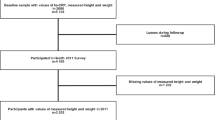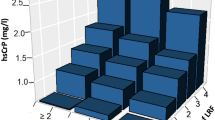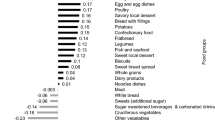Abstract
The objective of this study was to investigate whether serum high-sensitivity C-reactive protein (hs-CRP) concentration varies with dietary fatty acid intake in Iranian adults free of any history of cardiovascular disease (CVD). This cross-sectional study involved 8105 adults (3142 men) aged 35–65 years. Dietary intake was assessed using 24-h dietary recalls. The relationship between anthropometric, cardiometabolic risk factors and dietary data and serum hs-CRP was assessed using SPSS software. Median crude dietary saturated fat decreased across hs-CRP quarters (P =0.009 for linear trend), whereas energy-adjusted total fat (P =0.017), trans-fat (P =0.016), monounsaturated fatty acids (P =0.030) and cholesterol (P =0.005) monotonically increased, with some evidence of statistical interactions by gender. In conclusion, serum hs-CRP concentrations were associated with some components of dietary fatty acid intake in our population of individuals without CVD, suggesting that dietary fat intake could be associated with subclinical inflammation.
This is a preview of subscription content, access via your institution
Access options
Subscribe to this journal
Receive 12 print issues and online access
$259.00 per year
only $21.58 per issue
Buy this article
- Purchase on Springer Link
- Instant access to full article PDF
Prices may be subject to local taxes which are calculated during checkout
Similar content being viewed by others
References
Micallef MA, Garg ML . Anti-inflammatory and cardioprotective effects of n-3 polyunsaturated fatty acids and plant sterols in hyperlipidemic individuals. Atherosclerosis 2009; 204: 476–482.
DeBoer MD . Obesity, systemic inflammation, and increased risk for cardiovascular disease and diabetes among adolescents: a need for screening tools to target interventions. Nutrition 2013; 29: 379–386.
Santos S, Oliveira A, Casal S, Lopes C . Saturated fatty acids intake in relation to C-reactive protein, adiponectin, and leptin: A population-based study. Nutrition 2013; 29: 892–897.
Bian F, Yang X, Zhou F, Wu PH, Xing S, Xu G et al. C-reactive protein promotes atherosclerosis by increasing LDL transcytosis across endothelial cells. Br J Pharmacol 2014; 171: 2671–2684.
Kalogeropoulos N, Panagiotakos DB, Pitsavos C, Chrysohoou C, Rousinou G, Toutouza M et al. Unsaturated fatty acids are inversely associated and n-6/n-3 ratios are positively related to inflammation and coagulation markers in plasma of apparently healthy adults. Clin Chim Acta 2010; 411: 584–591.
Kong A, Neuhouser ML, Xiao L, Ulrich CM, McTiernan A, Foster-Schubert KE . Higher habitual intake of dietary fat and carbohydrates are associated with lower leptin and higher ghrelin concentrations in overweight and obese postmenopausal women with elevated insulin levels. Nutr Res 2009; 29: 768–776.
Petersson H, Lind L, Hulthe J, Elmgren A, Cederholm T, Riserus U . Relationships between serum fatty acid composition and multiple markers of inflammation and endothelial function in an elderly population. Atherosclerosis 2009; 203: 298–303.
Ghayour-Mobarhan M, Moohebati M, Esmaily H, Ebrahimi M, Parizadeh SM, Heidari-Bakavoli AR et al. Mashhad stroke and heart atherosclerotic disorder (MASHAD) study: design, baseline characteristics and 10-year cardiovascular risk estimation. Int J Public Health 2015; 60: 561–572.
Kazemi-Bajestani SM, Azarpazhooh MR, Ebrahimi M, Vedadian P, Esmaeili H, Parizadeh SM et al. Serum high sensitivity CRP concentrations predict the presence of carotid artery plaque in individuals without a history of cardiovascular events. Nutr Metab Cardiovasc Dis 2015; 25: 434–435.
Kelishadi R, Sharifi M, Khosravi A, Adeli K . Relationship between C-reactive protein and atherosclerotic risk factors and oxidative stress markers among young persons 10–18 years old. Clin Chem 2007; 53: 456–464.
Azarpazhooh MR, Kazemi-Bajestani SM, Esmaeili H, Vedadian P, Ebrahimi M, Parizadeh SM et al. Cardiovascular risk factors and nutritional intake are not associated with ultrasound-defined increased carotid intima media thickness in individuals without a history of cardiovascular events. Int J Prev Med 2014; 5: 1412–1421.
Smidowicz A, Regula J . Effect of nutritional status and dietary patterns on human serum C-reactive protein and interleukin-6 concentrations. Adv Nutr 2015; 6: 738–747.
Muka T, Kiefte-de Jong JC, Hofman A, Dehghan A, Rivadeneira F, Franco OH . Polyunsaturated fatty acids and serum C-reactive protein: the Rotterdam study. Am J Epidemiol 2015; 181: 846–856.
Bo S, Ciccone G, Guidi S, Gambino R, Durazzo M, Gentile L et al. Diet or exercise: what is more effective in preventing or reducing metabolic alterations? Eur J Endocrinol 2008; 159: 685–691.
Chait A, Kim F . Saturated fatty acids and inflammation: who pays the toll? Arterioscler Thromb Vasc Biol 2010; 30: 692–693.
Yeop Han C, Kargi AY, Omer M, Chan CK, Wabitsch M, O'Brien KD et al. Differential effect of saturated and unsaturated free fatty acids on the generation of monocyte adhesion and chemotactic factors by adipocytes: dissociation of adipocyte hypertrophy from inflammation. Diabetes 2010; 59: 386–396.
Schwartz EA, Zhang WY, Karnik SK, Borwege S, Anand VR, Laine PS et al. Nutrient modification of the innate immune response: a novel mechanism by which saturated fatty acids greatly amplify monocyte inflammation. Arterioscler Thromb Vasc Biol 2010; 30: 802–808.
McKiernan F, Lokko P, Kuevi A, Sales RL, Costa NM, Bressan J et al. Effects of peanut processing on body weight and fasting plasma lipids. Br J Nutr 2010; 104: 418–426.
Moreira Alves RD, Boroni Moreira AP, Macedo VS, Bressan J, de Cassia Goncalves Alfenas R, Mattes R et al. High-oleic peanuts: new perspective to attenuate glucose homeostasis disruption and inflammation related obesity. Obesity (Silver Spring, Md) 2014; 22: 1981–1988.
Ahluwalia N, Andreeva VA, Kesse-Guyot E, Hercberg S . Dietary patterns, inflammation and the metabolic syndrome. Diabetes Metab 2013; 39: 99–110.
Barbour JA, Howe PR, Buckley JD, Bryan J, Coates AM . Effect of 12 weeks high oleic peanut consumption on cardio-metabolic risk factors and body composition. Nutrients 2015; 7: 7381–7398.
Harvey KA, Walker CL, Xu Z, Whitley P, Pavlina TM, Hise M et al. Oleic acid inhibits stearic acid-induced inhibition of cell growth and pro-inflammatory responses in human aortic endothelial cells. J Lipid Res 2010; 51: 3470–3480.
Pai JK, Pischon T, Ma J, Manson JE, Hankinson SE, Joshipura K et al. Inflammatory markers and the risk of coronary heart disease in men and women. N Engl J Med 2004; 351: 2599–2610.
Julia C, Touvier M, Meunier N, Papet I, Galan P, Hercberg S et al. Intakes of PUFAs were inversely associated with plasma C-reactive protein 12 years later in a middle-aged population with vitamin E intake as an effect modifier. J Nutr 2013; 143: 1760–1766.
Scagliusi FB, Ferriolli E, Pfrimer K, Laureano C, Cunha CS, Gualano B et al. Underreporting of energy intake in Brazilian women varies according to dietary assessment: a cross-sectional study using doubly labeled water. J Am Diet Assoc 2008; 108: 2031–2040.
Acknowledgements
MM was supported by a TWAS studentship of the Chinese Academy of Sciences, during the preparation of this manuscript.
Author information
Authors and Affiliations
Corresponding author
Ethics declarations
Competing interests
The authors declare no conflict of interest.
Rights and permissions
About this article
Cite this article
Mazidi, M., Heidari-Bakavoli, A., Khayyatzadeh, S. et al. Serum hs-CRP varies with dietary cholesterol, but not dietary fatty acid intake in individuals free of any history of cardiovascular disease. Eur J Clin Nutr 70, 1454–1457 (2016). https://doi.org/10.1038/ejcn.2016.92
Received:
Revised:
Accepted:
Published:
Issue Date:
DOI: https://doi.org/10.1038/ejcn.2016.92
This article is cited by
-
Level and trend of total plasma cholesterol in national and subnational of Iran: a systematic review and age-spatio-temporal analysis from 1990 to 2016
Journal of Diabetes & Metabolic Disorders (2022)
-
Low adherence to CKD-specific dietary recommendations associates with impaired kidney function, dyslipidemia, and inflammation
European Journal of Clinical Nutrition (2021)
-
Serum trans-fatty acids level are positively associated with lower food security among american adults
Nutrition & Diabetes (2018)
-
Association between plasma trans fatty acids concentrations and leucocyte telomere length in US adults
European Journal of Clinical Nutrition (2018)



